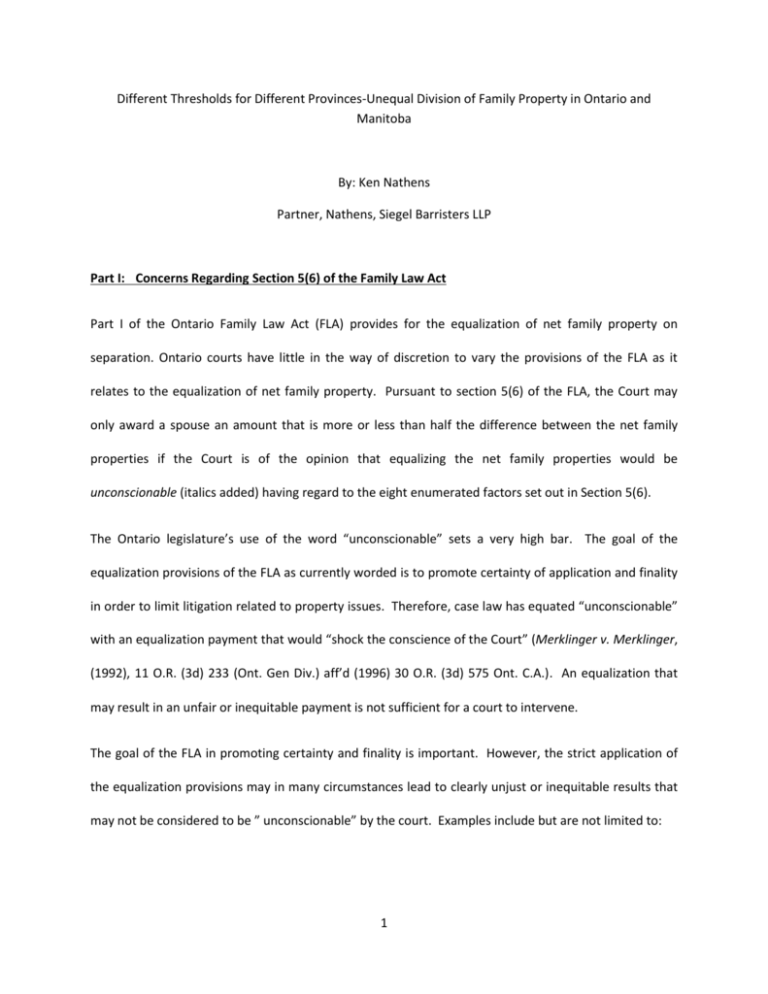pdf6 - Nathens, Siegel
advertisement

Different Thresholds for Different Provinces-Unequal Division of Family Property in Ontario and Manitoba By: Ken Nathens Partner, Nathens, Siegel Barristers LLP Part I: Concerns Regarding Section 5(6) of the Family Law Act Part I of the Ontario Family Law Act (FLA) provides for the equalization of net family property on separation. Ontario courts have little in the way of discretion to vary the provisions of the FLA as it relates to the equalization of net family property. Pursuant to section 5(6) of the FLA, the Court may only award a spouse an amount that is more or less than half the difference between the net family properties if the Court is of the opinion that equalizing the net family properties would be unconscionable (italics added) having regard to the eight enumerated factors set out in Section 5(6). The Ontario legislature’s use of the word “unconscionable” sets a very high bar. The goal of the equalization provisions of the FLA as currently worded is to promote certainty of application and finality in order to limit litigation related to property issues. Therefore, case law has equated “unconscionable” with an equalization payment that would “shock the conscience of the Court” (Merklinger v. Merklinger, (1992), 11 O.R. (3d) 233 (Ont. Gen Div.) aff’d (1996) 30 O.R. (3d) 575 Ont. C.A.). An equalization that may result in an unfair or inequitable payment is not sufficient for a court to intervene. The goal of the FLA in promoting certainty and finality is important. However, the strict application of the equalization provisions may in many circumstances lead to clearly unjust or inequitable results that may not be considered to be ” unconscionable” by the court. Examples include but are not limited to: 1 (i) Post separation fluctuations in asset values: Prior to Serra v. Serra 2009 ONCA 105 (Ont. C.A.) it had been accepted that property is to be valued as of the date of separation, and post separation date increases or decreases in value accrue to the benefit or detriment of the spouse who owns the asset. In many cases, property may be equalized years after separation. Pursuant to the FLA, spouses may claim equalization of property up to two years after divorce, or six years after the date of separation. In a situation of a severe real estate or stock market corrections post separation, as occurred in 2008 and 2009, a spouse may be required to equalize assets that are worth 40-50% less on the trial or settlement date than on the valuation date. It is not likely that the Serra decision will be widely applied to other cases with significant increases or decreases in property values post separation. In Serra, the major factor in the Court’s finding of unconscionability was the total decimation of the Canadian textile industry, which led the payor to owe an equalization payment more than his net worth. In less severe cases, such as major market downturns, it is not likely that the Court would make a finding that an equalization payment based on separation date values would be unconscionable. (ii) Unequal contributions to marital relationship: The FLA presumes that spouses will make equal contributions to a marriage. This is inherent in section 5 (7) of the FLA: The purpose of this section is to recognize that child care, household management and financial provision are the joint responsibilities of the spouses and that inherent in the marital relationship there is equal contributions, whether financial or otherwise, by the spouses to the assumption of these responsibilities, entitling each spouse to the 2 equalization of net family properties, subject only to the equitable considerations set out in subsection (6). There are numerous instances where spouses may not contribute to the well- being of the family, financial or otherwise. This may not be the fault of the individual spouse due to illness or addiction that may prevent a meaningful contribution. In other cases a spouse may lack work ethic, the ability or desire to participate in the bringing up the children of the marriage, or an ambition to accumulate wealth. In situations such as these, where it can be demonstrated that one spouse contributed far more to the general well- being of the family, financial or otherwise, than the other spouse, there should be some judicial discretion to vary the equalization payment that may be owed even if the equalization payment is not deemed to be “unconscionable”. (iii) Inheritances or gifts that are traced into a matrimonial home: Pursuant to the FLA, if an inheritance or gift is traced into a matrimonial home, the exclusion that would otherwise be available to the recipient of the gift or inheritance is lost. This is regardless of whether the gift or inheritance is placed into the matrimonial home one week prior to separation or ten years prior to separation. This may lead to an unfair situation where the recipient of the gift or inheritance, in good faith, places all or part of his or her gift or inheritance in the matrimonial home shortly prior to separation. The court ought to have some discretion to remedy this injustice to protect the exclusion of the gift or inheritance from being lost. What a reasonable time period may be between the time of the placement of the gift or the inheritance into the matrimonial home and separation that would warrant judicial intervention would be dependent on the amount of the inheritance, length of the relationship, and overall financial circumstances of the parties. 3 Part II: Manitoba Family Property Act The Manitoba Family Property Act CCSM c. F25 (FPAM) governs the division of marital assets in Manitoba. In many ways, its scheme regarding the division of marital property is similar to that of the FLA. Section 13 of the FPAM provides: Each spouse and common-law partner has the right upon application to an accounting, and subject to section 14, an equalization of assets in accordance with this Part. Assets are broadly defined to mean “any real or personal property, or legal or equitable interest therein, including without restricting generality of the foregoing, a chose in action, money, jewellery and a family home, but not including any article of personal apparel.” Further, pursuant to sections9(1) of the FPAM, assets may consist of mere rights, whether present, future, or continent, regardless of whether or not the rights have yet to be realized, but there is the possibility that the rights will be realized in the future. Despite the similarities between the FLA and the FPAM there are some major differences between the two statutes: These differences between the Ontario and Manitoba Act include, but are not limited to the following: 1. Pursuant to the definition section of the FPAM assets are defined as either a “family asset” which is an asset owned by one or two common law partners or spouses and used for shelter or transportation, or for household, educational, recreational, social or aesthetic purposes, 4 including , but not limited to a family home or an asset that may be owned by a corporation, partnership or trust, that if owned by a common law partner or spouse, would be a family asset and “commercial asset” that is defined as any asset that is not a family asset. The importance of the two different types of assets relates to the Court’s discretion in varying the equal division of the value of family assets as discussed below. 2. Pursuant to Division 1.1 of the FPAM, the legislation extends the equalization of property scheme to common law partners, defined as partners who have registered their relationship under the Manitoba Vital Statistics Act, or partners (same sex or opposite sex) who have lived in a conjugal relationship for a period of at least three years. The implication of this is very significant. As common law partners in Manitoba have similar property rights to married spouses on separation, lengthy court proceedings initiated by one partner to prove constructive trust interests in property owned by the other partner on separation should not be necessary as they are in Ontario. 3. Assets acquired before marriage or cohabitation: The general rule pursuant to section 4(2) of the FPAM is that assets acquired before marriage will not be included in the calculation of the equalization of assets on separation unless the asset was acquired by a spouse when that spouse was cohabiting in a conjugal relationship with the other spouse immediately before their marriage or the asset was acquired before, but in specific contemplation of the cohabitation or marriage to the other spouse. Similarly, an asset acquired by a common law partner before, but in specific contemplation of, the common law relationship is subject to equalization. There is no special provision in the FPAM, as there is in the FLA, regarding the treatment of a matrimonial 5 home (or “family home” under the FPAM) held on the date of marriage that precludes a spouse from deducting this asset in the equalization calculation. 4. Anti-Avoidance Rules: The FPAM grants the Court broad powers to remedy attempts by spouses or common law partners to thwart the Act, intentionally or unintentionally. Pursuant to Sections 6(7)-6(11) of the FPAM, should a spouse or common law partner (i) dissipate an asset in whole or in part, (ii) transfer an asset by way of a gift to a third party that the Court views is excessive, or (iii) transfer an asset for inadequate consideration, then the other spouse has the right within two years from the date of the transaction, on an application for an accounting and equalization, to request that the value of the depleted or gifted asset be added back to the inventory of assets of the spouse in the accounting. No intent to defeat the FPAM must be proven by the applicant spouse in order for the remedy to be granted, except in the case of a transfer of an asset for inadequate consideration which requires evidence of intent prior to the remedy being granted. Unlike section 5(6) of the FLA, the applicant does not have to prove that the depletion of the asset or excessive gift leads to an “unconscionable” result, merely that the transaction has taken place. Section 6(10) of the FPAM also provides the Courts with jurisdiction to hold the third party recipient of the gift or property obtained for inadequate consideration responsible for payment of the equalization of assets, if the transferor spouse does not have the financial means to make the payment. 5. Judicial discretion to vary equal division of family assets: Pursuant to section 14(1) and 14 (2) of the FPAM, the Court is given discretion to vary the equalization of assets. The nature of the Court’s discretion is dependent on the type of asset: 6 (i) If an asset is a “family asset”, Manitoba courts have limited jurisdiction to vary the accounting and equal division of assets. Pursuant to section 14(1) of the FPAM In order for a Manitoba court to have authority to vary the equalization of family assets, it must be satisfied that equalization would be “grossly unfair or unconscionable having regard to any extraordinary financial or other circumstances of the spouses or common law partners or the extraordinary nature or value of any of their assets.” Thus, the wording of the Manitoba legislation appears to be slightly more open ended than is section 5(6) of the FLA by adding “grossly unfair” as a threshold for variation of an equalization of assets in addition to the stricter “unconscionable” test. (ii) In the case of “commercial assets” there is a much wider discretion given to Manitoba courts to vary the equalization accounting. The Court may alter the equalization of commercial assets in the event that the court is satisfied that equalization would be “clearly inequitable” having regard to a number of circumstances set out in section 14(2) of the FPAM, including (i) one partner’s impoverishment of the family assets, (ii) the amount of debt incurred by each partner, (iii) any spousal or common law agreements, (iv) the length of the marriage or cohabitation, (v) the value of gifts or inheritances one partner may hold that would be excluded, (vi) the extent to which the financial means and earning capacity of a partner has been affected by the responsibilities and other circumstances of the marriage or common law relationship. The lower standard to vary the equalization of commercial assets provided by the FPAM is in marked contrast to the FLA where all assets are treated in a similar way, regardless of whether used personally or for business use, and regardless of individual contributions made by a partner to the financial means of the parties. 7 Conclusion Regarding FPAM The FPAM in many ways improves upon the FLA. Most important, it extends coverage to common law partners, which is in my view represents significant legislative progress and the recognition that in modern Canada it is necessary to legislate common law property rights to avoid the uncertainty and prohibitive costs of arguing common law property rights through the doctrine of constructive trust. Further, the FPAM has effective anti –avoidance provisions to avoid intentional or unintentional attempts to thwart the purposes of the Act. Finally, if a spouse in Manitoba claims the unequal division of family or commercial assets, the Manitoba legislation, particularly in the case of commercial assets, provides the Manitoba courts with much greater discretion to grant an equitable, as opposed to a purely formulistic resolution to family law property disputes. 8








